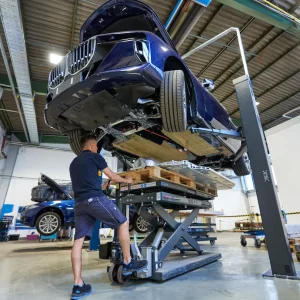As is generally the case with all Japanese brands, Toyota has always been a manufacturer more successful in the retail arena than in the business car market, but 2013 is the time when it makes a more serious dent into the corporate sphere after spending 2012 preparing to make an assault.
“We spent an awful lot of effort [last] year to get a foundation in fleet – it’s a fundamental pillar of our growth strategy,” Toyota GB commercial director Matt Harrison tells BusinessCar. “For quite a while Toyota has overperformed in retail and underperformed in fleet – we’re constantly pushing 5% in retail and getting more like 3-4% in fleet.”
The reason for that, and the big thing Toyota is rectifying in 2013, is the competitiveness of what it describes as its C-segment product, across lower medium hatchback, estate, SUV and MPV – essentially the Auris, Rav4 and Verso models. “Across all elements we’ve not had the product desirability to really deliver, but we’re putting the foundations in for significant growth this year.”
The new Auris, driven by BusinessCar in December 2012, will be joined during 2013 by an estate variant, with the Verso people carrier and Rav4 small off-roader replaced by new models.
“After four years of falling back in terms of share and volume, we’ve got positive energy back and hope it’s the start of things to come as we see [this] year as the year of opportunity,” Harrison continues. “We’ve got a very cautious view of the market and economy, so we’re being very cautious about believing the market recovery will enable growth, and consequently that growth can only come from taking share from the competition.”
Harrison says the new Auris, Verso and Rav4 account for 25-30% of Toyota’s volume. The biggest one in volume terms is the new Auris hatchback, joined for the first time by an estate model. “We believe we’ve a really big job to do with the Auris, probably more than any other car,” reveals Harrison. “It’s still a growing nameplate – we only launched it in 2006/07, and in reality when the 2010 minor change came it was the same time as a lot of recall activity, so there was a diversion of funds away from launching a new model, with the downside that we’ve underinvested in the credentials of the Auris brand.
“We’ve got work to do to invest and get ourselves on the consideration set. Our strategy, probably for the first time, is fleet first. We’ve got more to deliver – we’ve underperformed significantly in fleet with this car and the work is to reverse this trend,” he says. “That doesn’t mean doing a lot of Motability or daily rental – we’ve got to get new people out there driving cars to get a whole new focus on fleet business.”
The target is an additional 10,000 corporate registrations over the next three years, with 70% of that coming from the Auris across hatchback and estate, taking Toyota to a fleet volume of around 50,000. “We’ve tried to make sure with the Auris that we’ve got a very generous position; we’re head-on with the competition that’s doing well at the moment – Kia and Hyundai,” says Harrison. “Where you expect to sell volume is £500 below the Focus and we’ve pushed very hard to make sure we’re visibly below Ford, then you spec-adjust. People need to understand the accessibility of the product and we’re not trying to be unrealistic in terms of the price of the car.”
The new Verso people carrier is another vehicle Toyota hopes will increase volume. “The segment in general is 75-85% fleet so it’s predominantly a business sector, but it has been distorted by Motability and rental, which is a high content of the sector,” says Harrison. “In the past couple of years we’ve seen a lot of people pull back at the cost of doing business in those sectors and I see the Verso as a big opportunity – it has a 7% sector share in retail but less than 2% in fleet.
“Toyota wants to be a major volume player in the UK and you can’t do that without getting your fair share of each sector,” he adds. “We would like a share of Motability but we don’t build cars unless we have a customer. We are now looking at the business in a different way and are able to be less sporadic – there was an approach of stepping in and out when it suited us but we’re now able to put an end to that.”
Toyota is also looking to get more recognition and value from its five-year, 100,000-mile warranty offering, which compares favourably with the three years offered by the likes of Ford, VW and the French brands: “The warranty is a major advantage. We know from research what value our customers derive from that and we are trying to find more ways of leveraging it at the moment, particularly for business.”
The model burst in 2013 follows the launch of several new vehicles in the summer of 2012, with the Prius+, Prius Plug-in, Yaris Hybrid and GT86 sports car all reaching the market, although the firm admits none are significant corporate volume propositions.
“If you look at the absolute contributions of the four new products it’s not significant to the growth we’ve achieved; in share terms, we’re up there with mainstream brands that are share winners,” says Harrison. “We’ll see how the GT86 changes people’s opinion of the brand, and the biggest success of all in absolute volume terms is the Yaris hybrid with 79g/km – it’s been a bit of a revolution, and with fleets the demand has been stronger than anticipated.
“2013 is the year of opportunity. We will start to take what we see as our fair share of the fleet market,” Harrison concludes. “There’s no reason why Toyota should take less fleet than retail – our overall approach of cost of ownership, customer service and reliability should maybe appeal to fleet more than retail.”





